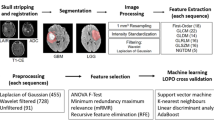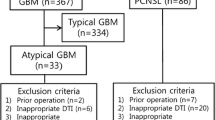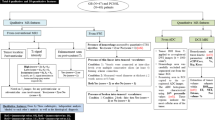Abstract
Purpose
To determine the feasibility of using high dimensional computer-extracted features, known as radiomics features, in differentiating primary central nervous system lymphoma (PCNSL) from glioblastoma on multi-parametric MR imaging including diffusion-weighted imaging.
Methods
Retrospective evaluation of data was approved by the local ethics committee and informed consent was waived. A total of 143 patients (two independent cohorts for discovery [n = 86; glioblastoma = 49, PCNSL = 37] and validation [n = 57; glioblastoma = 29, PCNSL = 28]) with newly diagnosed glioblastoma and PCNSL were subjected to radiomics analysis using the multi-parametric MRI (contrast-enhanced T1-weighted imaging, T2-weighted imaging, and diffusion-weighted imaging). Radiomics analyses were performed for two types of regions of interest (ROI) covering contrast-enhancing tumor and whole (enhancing or non-enhancing) tumor plus peritumoral edema. A total of 127 radiomics features were calculated. Feature selection was performed to identify the most discriminating features for every MR image in the discovery cohort. The identified features were used to calculate radiomics scores, which were later used in logistic regression to distinguish between PCNSL and glioblastoma. The classification model was further tested on the independent validation cohort.
Results
Fifteen features were selected as significant features in the discovery cohort. Using the identified features and calculated radiomics scores, the logistic regression-based classifier yielded an area under the curve (AUC) of 0.979, sensitivity of 0.938, and specificity of 0.944 in the discovery cohort to distinguish between glioblastoma and PCNSL. A similarly high rate of performance was observed in the validation cohort (AUC = 0.956).
Conclusions
Radiomics features derived from multi-parametric MRI can be used to differentiate PCNSL from glioblastoma effectively.



Similar content being viewed by others
Abbreviations
- CE-T1:
-
Contrast material-enhanced T1-weighted
- GLCM:
-
Gray-level co-occurrence matrix
- LASSO:
-
Least absolute shrinkage and selection operator
- mRMR:
-
Minimum redundancy maximum relevance
- PCNSL:
-
Primary central nervous system lymphoma
- RF:
-
Random forest
- SVM:
-
Support vector machine
References
Schlegel U (2009) Primary CNS lymphoma. Ther Adv Neurol Disord 2:93–104
Stupp R, Mason WP, van den Bent MJ, Weller M, Fisher B, Taphoorn MJ, Belanger K, Brandes AA, Marosi C, Bogdahn U, Curschmann J, Janzer RC, Ludwin SK, Gorlia T, Allgeier A, Lacombe D, Cairncross JG, Eisenhauer E, Mirimanoff RO, European Organisation for R, Treatment of Cancer Brain T, Radiotherapy G, National Cancer Institute of Canada Clinical Trials G (2005) Radiotherapy plus concomitant and adjuvant temozolomide for glioblastoma. N Engl J Med 352:987–996
Buhring U, Herrlinger U, Krings T, Thiex R, Weller M, Kuker W (2001) MRI features of primary central nervous system lymphomas at presentation. Neurology 57:393–396
Al-Okaili RN, Krejza J, Woo JH, Wolf RL, O’Rourke DM, Judy KD, Poptani H, Melhem ER (2007) Intraaxial brain masses: MR imaging-based diagnostic strategy--initial experience. Radiology 243:539–550
Haldorsen IS, Espeland A, Larsson EM (2011) Central nervous system lymphoma: characteristic findings on traditional and advanced imaging. AJNR Am J Neuroradiol 32:984–992
DeAngelis LM (1999) Primary CNS lymphoma: treatment with combined chemotherapy and radiotherapy. J Neuro-Oncol 43:249–257
Aerts HJ, Velazquez ER, Leijenaar RT, Parmar C, Grossmann P, Carvalho S, Bussink J, Monshouwer R, Haibe-Kains B, Rietveld D, Hoebers F, Rietbergen MM, Leemans CR, Dekker A, Quackenbush J, Gillies RJ, Lambin P (2014) Decoding tumour phenotype by noninvasive imaging using a quantitative radiomics approach. Nat Commun 5:4006
Gevaert O, Mitchell LA, Achrol AS, Xu J, Echegaray S, Steinberg GK, Cheshier SH, Napel S, Zaharchuk G, Plevritis SK (2014) Glioblastoma multiforme: exploratory radiogenomic analysis by using quantitative image features. Radiology 273:168–174
Itakura H, Achrol AS, Mitchell LA, Loya JJ, Liu T, Westbroek EM, Feroze AH, Rodriguez S, Echegaray S, Azad TD, Yeom KW, Napel S, Rubin DL, Chang SD, GRt H, Gevaert O (2015) Magnetic resonance image features identify glioblastoma phenotypic subtypes with distinct molecular pathway activities. Sci Transl Med 7:303ra138
Gillies RJ, Kinahan PE, Hricak H (2016) Radiomics: images are more than pictures, they are data. Radiology 278:563–577
Lambin P, Rios-Velazquez E, Leijenaar R, Carvalho S, van Stiphout RG, Granton P, Zegers CM, Gillies R, Boellard R, Dekker A, Aerts HJ (2012) Radiomics: extracting more information from medical images using advanced feature analysis. Eur J Cancer 48:441–446
Kang D, Park JE, Kim YH, Kim JH, Oh JY, Kim J, Kim Y, Kim ST, Kim HS (2018) Diffusion radiomics as a diagnostic model for atypical manifestation of primary central nervous system lymphoma: development and multicenter external validation. Neuro-Oncology 20:1251–1261
Suh HB, Choi YS, Bae S, Ahn SS, Chang JH, Kang SG, Kim EH, Kim SH, Lee SK (2018) Primary central nervous system lymphoma and atypical glioblastoma: differentiation using radiomics approach. Eur Radiol 28:3832–3839
Avants, BB, Tustison N, Gang S (2009) “Advanced normalization tools (ANTS)”. Insight J 2: 1–35
Davnall F, Yip CS, Ljungqvist G, Selmi M, Ng F, Sanghera B, Ganeshan B, Miles KA, Cook GJ, Goh V (2012) Assessment of tumor heterogeneity: an emerging imaging tool for clinical practice? Insights Imaging 3:573–589
Tixier F, Le Rest CC, Hatt M, Albarghach N, Pradier O, Metges JP, Corcos L, Visvikis D (2011) Intratumor heterogeneity characterized by textural features on baseline 18F-FDG PET images predicts response to concomitant radiochemotherapy in esophageal cancer. J Nucl Med 52:369–378
Grove O, Berglund AE, Schabath MB, Aerts HJ, Dekker A, Wang H, Velazquez ER, Lambin P, Gu Y, Balagurunathan Y, Eikman E, Gatenby RA, Eschrich S, Gillies RJ (2015) Quantitative computed tomographic descriptors associate tumor shape complexity and intratumor heterogeneity with prognosis in lung adenocarcinoma. PLoS One 10:e0118261
Haralick RM, Shanmugam K (1973) Textural features for image classification. IEEE Trans Syst Man Cybern SMC-3:610–621
Peng H, Long F, Ding C (2005) Feature selection based on mutual information: criteria of max-dependency, max-relevance, and min-redundancy. IEEE Trans Pattern Anal Mach Intell 27:1226–1238
van Griethuysen JJM, Fedorov A, Parmar C, Hosny A, Aucoin N, Narayan V, Beets-Tan RGH, Fillion-Robin JC, Pieper S, Aerts H (2017) Computational Radiomics system to decode the radiographic phenotype. Cancer Res 77:e104–e107
Alcaide-Leon P, Dufort P, Geraldo AF, Alshafai L, Maralani PJ, Spears J, Bharatha A (2017) Differentiation of enhancing glioma and primary central nervous system lymphoma by texture-based machine learning. AJNR Am J Neuroradiol 38:1145–1150
Yamasaki T, Chen T, Hirai T, Murakami R (2013) Classification of cerebral lymphomas and glioblastomas featuring luminance distribution analysis. Comput Math Methods Med 2013:619658
Kunimatsu A, Kunimatsu N, Kamiya K, Watadani T, Mori H, Abe O (2017) Comparison between glioblastoma and primary central nervous system lymphoma using MR image-based texture analysis. Magn Reson Med Sci
Claes A, Idema AJ, Wesseling P (2007) Diffuse glioma growth: a guerilla war. Acta Neuropathol 114:443–458
Kovalev VA, Kruggel F, Gertz HJ, von Cramon DY (2001) Three-dimensional texture analysis of MRI brain datasets. IEEE Trans Med Imaging 20:424–433
Mahmoud-Ghoneim D, Toussaint G, Constans JM, de Certaines JD (2003) Three dimensional texture analysis in MRI: a preliminary evaluation in gliomas. Magn Reson Imaging 21:983–987
Hassaneen W, Levine NB, Suki D, Salaskar AL, de Moura Lima A, McCutcheon IE, Prabhu SS, Lang FF, DeMonte F, Rao G, Weinberg JS, Wildrick DM, Aldape KD, Sawaya R (2011) Multiple craniotomies in the management of multifocal and multicentric glioblastoma, Clinical article. J Neurosurg 114:576–584
Bathla G, Hegde A (2016) Lymphomatous involvement of the central nervous system. Clin Radiol 71:602–609
Wang S, Kim S, Chawla S, Wolf RL, Knipp DE, Vossough A, O’Rourke DM, Judy KD, Poptani H, Melhem ER (2011) Differentiation between glioblastomas, solitary brain metastases, and primary cerebral lymphomas using diffusion tensor and dynamic susceptibility contrast-enhanced MR imaging. AJNR Am J Neuroradiol 32:507–514
Yamasaki F, Kurisu K, Satoh K, Arita K, Sugiyama K, Ohtaki M, Takaba J, Tominaga A, Hanaya R, Yoshioka H, Hama S, Ito Y, Kajiwara Y, Yahara K, Saito T, Thohar MA (2005) Apparent diffusion coefficient of human brain tumors at MR imaging. Radiology 235:985–991
Ko CC, Tai MH, Li CF, Chen TY, Chen JH, Shu G, Kuo YT, Lee YC (2016) Differentiation between glioblastoma multiforme and primary cerebral lymphoma: additional benefits of quantitative diffusion-weighted MR imaging. PLoS One 11:e0162565
Kolakshyapati M, Adhikari RB, Karlowee V, Takayasu T, Nosaka R, Amatya VJ, Takeshima Y, Akiyama Y, Sugiyama K, Kurisu K, Yamasaki F (2017) Nonenhancing peritumoral hyperintense lesion on diffusion-weighted imaging in glioblastoma: a novel diagnostic and specific prognostic indicator. J Neurosurg:1–12
Author information
Authors and Affiliations
Corresponding author
Ethics declarations
Funding
This study was funded by the Institute for Basic Science (Grant no. IBS-R015-D1), the National Research Foundation of Korea (Grant no. NRF-2016R1A2B4008545) and the Ministry of Science and ICT of Korea under the ITRC Program (Grant no. IITP-2018-0-01798).
Conflict of interest
The authors declare that they have no conflict of interest.
Ethical approval
All procedures performed in studies involving human participants were in accordance with the ethical standards of the institutional and/or national research committee and with the 1964 Helsinki declaration and its later amendments or comparable ethical standards. For this type of study formal consent is not required.
Informed consent
For this type of retrospective study formal consent is not required.
Electronic supplementary material
Supplementary Table 1
(DOCX 29 kb)
Supplementary Table 2
(DOCX 29 kb)
Supplementary Table 3
(DOCX 15 kb)
Supplementary Table 4
(DOCX 16 kb)
Supplementary Table 5
(DOCX 16 kb)
Rights and permissions
About this article
Cite this article
Kim, Y., Cho, Hh., Kim, S.T. et al. Radiomics features to distinguish glioblastoma from primary central nervous system lymphoma on multi-parametric MRI. Neuroradiology 60, 1297–1305 (2018). https://doi.org/10.1007/s00234-018-2091-4
Received:
Accepted:
Published:
Issue Date:
DOI: https://doi.org/10.1007/s00234-018-2091-4




